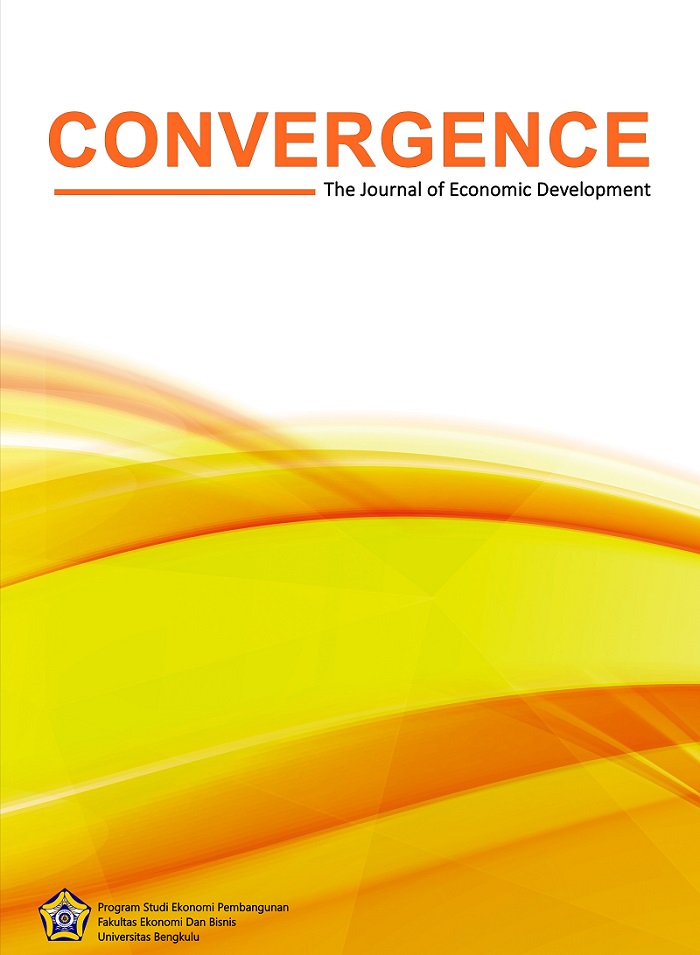Main Article Content
Abstract
The paper conducts a quantitative appraisal of existing empirical testing on economic variable determinants of welfare in Bengkulu Province, analyze how economic growth dan income inequality affect welfare in Bengkulu Province directly or and using an intermediary variable. To capture this issue, path analysis is applied in this study as to the analysis method. The study addressed the measurement of the welfare of Bengkulu Province using the Human Development Index, and using the Williamson Index as representative of income inequality, also apply observational data for all variables in the period 2005-2017. The result shows that economic growth and income inequality to be associated with welfare in Bengkulu Province, and income inequality is proven an intervening variable affecting welfare.
Keywords : Welfare1, Economic Growth2, dan Income Inequality 3
Keywords
Article Details
- This statement is a commitment from the author, to respect copyright, both in terms of quoting the work of others, as well as in the use of journal content.
- If needed, the author can send a statement of authenticity of the manuscript. With the receipt of an article by the Editor of Convergence: The Journal of Economic Development, the article submitted has the copyright held by Convergence: The Journal of Economic Development Convergence:
- The Journal of Economic Development has the right to reproduce and distribute articles that have been published in journals.
- The author is not permitted to publish the same article that has been published in this journal.
References
- Anwar A. (2005). Ketimpangan Wilayah dan Pedesaan: Tinjauan Kritis. Bogor: P4W Press.
- Arsyad, Lincolin. (2010). Ekonomi Pembangunan. Yogyakarta : Penerbit STIM YKPN.
- Badan Perencanaan Pembangunan Nasional (Bappenas). (2013). Analisis Kesenjangan Antar Wilayah 2013. Jakarta: Bappenas.
- Chang, J. Y., Ram, R. (2000). Level of Development, rate of Economic Growth and Income Inequality. Economic Development and Cultural Change, 48(4), 787-799.
- Kuncoro, Mudrajad. (2010). Dasar- dasar Ekonomika Pembangunan. Yogyakarta : UPP STIM YKPN.
- Kuznets, Simon. (1955). Economic Growth and Income Inequality. The American Economic Review, 45 (1), 1-28.
- Lanjouw, P., M. Pradhan, Saadah, H. Sayed, R. Sparrow. (2001). Poverty, Education and Health in Indonesia: Who Benefits from Public Spending? World Bank Working Paper No. 2739. Washington D.C.: World Bank.
- Mirza, Denni Sulistio. (2012). Pengaruh Kemiskinan, Pertumbuhan Ekonomi, dan Belanja Modal terhadap Indeks Pembangunan Manusia di Jawa Tengah 2006-2009. Jurnal Ekonomi Pembangunan, 1, 1-15.
- Oates, W. (1993). Fiscal Decentralization and Economic Development. National Tax Journal, 46 (2), 237-243.
- Ruduwan dan Engkos Achmad Kuncoro. (2008). Cara Menggunakan dan Memaknai Path Analysis (Analisis Jalur). Bandung: Penerbit Alfabeta.
- Sarel, Michael. (1997). How Macroeconomic Factors Affect Income Distribution: The Cross-Country Evidence. IMF Working Paper No. 152.
- Sarwono, Jonathan. (2010). Analisis Jalur Untuk Riset Bisnis dengan SPSS Edisi 5. Yogyakarta: Penerbit Andi.
- Sjafrizal. (2008). Ekonomi Regional Teori dan Aplikasi. Padang : Penerbit Baduose Media.
- Streiner, David L. (2005). Finding Our Way: An Introduction to Path Analysis. Can J Psychiatry, 50 (2), 115-122.
- Todaro, Micheal P dan Stephen C. Smith. 2012. Economic Development 11th edition. United States of America : Pearson.
- UNDP. 2000. Human Development Report. New York: United Nation.
- Xu, L. C., Zou, H. 2000. Explaining the Changes of Income distribution in China. China economic Review, 11 (2), 149-170.
- Rambe, A.Roosemarina., & Purmini. (2020). Kemampuan Belanja Pemerintah dan Pertumbuhan Ekonomi dalam Menurunkan Tingkat Kemiskinan: Bukti Empiris dari Sumatera dan Jawa. Convergence: The Journal of Economic Development, 2(1), 1-15.
References
Anwar A. (2005). Ketimpangan Wilayah dan Pedesaan: Tinjauan Kritis. Bogor: P4W Press.
Arsyad, Lincolin. (2010). Ekonomi Pembangunan. Yogyakarta : Penerbit STIM YKPN.
Badan Perencanaan Pembangunan Nasional (Bappenas). (2013). Analisis Kesenjangan Antar Wilayah 2013. Jakarta: Bappenas.
Chang, J. Y., Ram, R. (2000). Level of Development, rate of Economic Growth and Income Inequality. Economic Development and Cultural Change, 48(4), 787-799.
Kuncoro, Mudrajad. (2010). Dasar- dasar Ekonomika Pembangunan. Yogyakarta : UPP STIM YKPN.
Kuznets, Simon. (1955). Economic Growth and Income Inequality. The American Economic Review, 45 (1), 1-28.
Lanjouw, P., M. Pradhan, Saadah, H. Sayed, R. Sparrow. (2001). Poverty, Education and Health in Indonesia: Who Benefits from Public Spending? World Bank Working Paper No. 2739. Washington D.C.: World Bank.
Mirza, Denni Sulistio. (2012). Pengaruh Kemiskinan, Pertumbuhan Ekonomi, dan Belanja Modal terhadap Indeks Pembangunan Manusia di Jawa Tengah 2006-2009. Jurnal Ekonomi Pembangunan, 1, 1-15.
Oates, W. (1993). Fiscal Decentralization and Economic Development. National Tax Journal, 46 (2), 237-243.
Ruduwan dan Engkos Achmad Kuncoro. (2008). Cara Menggunakan dan Memaknai Path Analysis (Analisis Jalur). Bandung: Penerbit Alfabeta.
Sarel, Michael. (1997). How Macroeconomic Factors Affect Income Distribution: The Cross-Country Evidence. IMF Working Paper No. 152.
Sarwono, Jonathan. (2010). Analisis Jalur Untuk Riset Bisnis dengan SPSS Edisi 5. Yogyakarta: Penerbit Andi.
Sjafrizal. (2008). Ekonomi Regional Teori dan Aplikasi. Padang : Penerbit Baduose Media.
Streiner, David L. (2005). Finding Our Way: An Introduction to Path Analysis. Can J Psychiatry, 50 (2), 115-122.
Todaro, Micheal P dan Stephen C. Smith. 2012. Economic Development 11th edition. United States of America : Pearson.
UNDP. 2000. Human Development Report. New York: United Nation.
Xu, L. C., Zou, H. 2000. Explaining the Changes of Income distribution in China. China economic Review, 11 (2), 149-170.
Rambe, A.Roosemarina., & Purmini. (2020). Kemampuan Belanja Pemerintah dan Pertumbuhan Ekonomi dalam Menurunkan Tingkat Kemiskinan: Bukti Empiris dari Sumatera dan Jawa. Convergence: The Journal of Economic Development, 2(1), 1-15.
